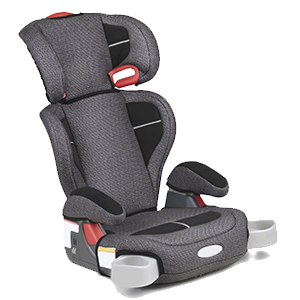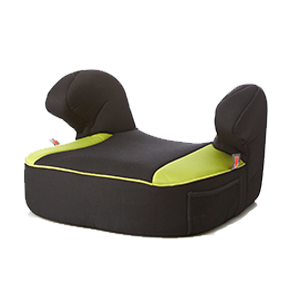A public service program of:

A public service program of:

 Booster Seat Safety
Booster Seat SafetyYour child is ready for a booster seat once he or she has reached the maximum height or weight limit for the child's forward-facing seat.
Understanding Georgia's Booster Seat Law
Effective July 1st, 2011 – All children in Georgia under the age of 8, are required by law to be in a car seat or a booster seat appropriate for their height and weight, and used according to the manufacturer's instructions. The law also requires children under the age of 8 to ride in the back seat. It is recommended that children under the age of 12 ride in the back seat of the vehicle whenever possible.
For more information on the new booster seat law, including exemptions, exceptions, fines and citations, please visit the website for the Governor’s Office of Highway Safety [1] at www.gahighwaysafety.org

A high back booster seat is needed if your vehicle has low seat backs or does not have headrests.

A backless booster could be used if your vehicle has high seat backs and/or headrests.
In order to use a backless booster seat the vehicle seat and/or headrests MUST come up to your child’s ears. If your child’s ears go past the vehicle seat and/or the headrests then your child should use a high back booster seat in order to protect their head and neck in the event of a car crash.
All photos are for demonstration purposes only


5 years old (approx.) – Age 8. Children under the age of 8 are required by law to ride in a car seat or booster seat appropriate for their height and weight, unless the parent has written documentation that the child is over 4’9” (57 inches).
Your child is ready for a booster seat once they have reached the maximum height or weight limit for his or her forward-facing car seat. Remember that with every step forward there is a reduction in the level of protection and safety. So don't rush to the next stage.
Georgia law requires that all children under the age of 8 whose height is less than 4'9" (57 inches) are required to be in either a car seat or a booster seat suitable for their age, height and weight and must ride in the backseat of a vehicle.
When using a booster seat, make sure the lap and shoulder belt fits properly. The lap belt must lie snugly across the upper thighs, not the stomach. The shoulder belt should lie snugly across the shoulder and chest and not cross the child's neck or face.
Many booster seats have a weight range starting at 30-40 pounds, with a maximum weight of 80-100+ pounds. The National Child Passenger Safety Board [2] recommends keeping your child in a booster seat until the vehicle seat belt fits your child properly, and he or she is mature enough to sit without slouching for the entire ride.
5 years old (approx.) – Age 8. Children under the age of 8 are required by law to ride in a car seat or booster seat appropriate for their height and weight, unless the parent has written documentation that the child is over 4’9” (57 inches).
Your child is ready for a booster seat once they have reached the maximum height or weight limit for his or her forward-facing car seat. Remember that with every step forward there is a reduction in the level of protection and safety. So don't rush to the next stage.
Georgia law requires that all children under the age of 8 whose height is less than 4'9" (57 inches) are required to be in either a car seat or a booster seat suitable for their age, height and weight and must ride in the backseat of a vehicle.
When using a booster seat, make sure the lap and shoulder belt fits properly. The lap belt must lie snugly across the upper thighs, not the stomach. The shoulder belt should lie snugly across the shoulder and chest and not cross the child's neck or face.
Many booster seats have a weight range starting at 30-40 pounds, with a maximum weight of 80-100+ pounds. The National Child Passenger Safety Board [2] recommends keeping your child in a booster seat until the vehicle seat belt fits your child properly, and he or she is mature enough to sit without slouching for the entire ride.
View All StagesBooster seats are held in place by the child’s weight and by the lap and shoulder belt in the vehicle.
To install, place the booster seat in the back seat of your vehicle, making sure it sits flat on the vehicle seat, not tilted or turned. Have your child sit in the booster seat, place the seat belt across your child’s body and buckle it.
Before attempting to install any car seat or booster seat it’s important to always read the booster seat owner's manual and the child restraint section in your vehicle owner's manual.
Check the expiration date on your booster seat before installing. Never use an expired booster seat.
Lesser Known Safety Tip: If you have a booster seat in your vehicle and your child is not present, make sure your booster seat is secured to the vehicle seat using the seat belt. In the event of a crash or a sudden stop an unsecured booster seat could cause serious injuries to passengers.

Once your child has outgrown a forward-facing car seat, it's important to know the safest way to secure your child in a booster seat. Georgia law requires children under the age of 8, and whose height in less than 4'9" (57 inches), to ride in a car seat or booster seat appropriate for their weight and height, and travel in the backseat of the vehicle [5]. Watch the easy-to-follow video, created by iRideSafe™, to help you properly secure your child in a booster seat.
To help you determine if your child is ready for a booster seat, take this 5-step test developed by Safety Belt Safe U.S.A. [6]

Your child’s safety is important to us! Please make sure they are always buckled up and in the appropriate car seat. Below are some additional resources to help keep your family safe on the road.

Email: [email protected]
Call: 404-529-6333 Ext. 375
Keep your child in a belt-positioning booster seat as long as possible. Do not transition them out of it until you are certain the vehicle seat belt fits him or her correctly. Remember that with every step forward there is a reduction in the level of protection and safety. So please don’t rush to the next stage.

Birth – Until at least 2 years old. Keep your child rear-facing until he or she reaches the maximum height or weight limit allowed by the car seat manufacturer. (Transition to the next stage at approx. age 2).
Remember rear-facing does a better job protecting the child's head, neck, spine and back in a crash.
There is no need to rush to move on to the next car seat or booster seat.
Children under age 2 should ALWAYS ride in a rear-facing car seat in the back seat of the car. Never place a rear-facing car seat in the front seat. Consult your vehicle owner's manual for further information.
The American Academy of Pediatrics (AAP) recommends that all children under the age of 2 should remain in a rear-facing car seat, and that children 2 and older should continue to ride rear-facing as long as possible, until they reach the maximum height or weight limit allowed by the car seat manufacturer. [7]
"A rear-facing child safety seat does a better job of supporting the head, neck and spine of infants and toddlers in a crash, because it distributes the force of the collision over the entire body", according to the AAP.
When purchasing a rear-facing car seat, please note that there are different types available:
Birth – Until at least 2 years old. Keep your child rear-facing until he or she reaches the maximum height or weight limit allowed by the car seat manufacturer. (Transition to the next stage at approx. age 2)


2 years old (approx.) – Until your child reaches the maximum height or weight limit allowed by the car seat manufacturer. (Average transition to the next stage is at approx. age 5).
The American Academy of Pediatrics recommends that "all infants and toddlers ride in a rear-facing car seat until they are 2 years of age or until they reach the maximum height or weight limit allowed by the car seat manufacturer." [8]
Once your child has outgrown the rear-facing car seat, he or she should ride in a forward-facing car seat, in the backseat, and until your child reaches the maximum height or weight limit according to the forward-facing car seat manufacturer. Remember that with every step forward there is a reduction in the level of protection and safety, so don’t rush to the next stage.
Types of forward-facing seats include: forward-facing convertible, combination car seats and all-in-one. Whichever type you select, be sure to check the height and weight limits to ensure the proper usage for your child.
According to National Highway Traffic Safety Administration (NHTSA) 3 out of every 4 car seats are not properly secured [9]. Don’t take any chances! Get to know your car seat.
Protect your smallest passengers. It's important to always have your child properly restrained in a car seat or booster seat until the age of eight (8) while traveling on the streets, highways, and byways. In Georgia, it's the law. [10]
2 years old (approx.) – Until your child reaches the maximum height or weight limit allowed by the car seat manufacturer. (Average transition to the next stage is at approx. age 5)


5 years old (approx.) – Age 8. Children under the age of 8 are required by law to ride in a car seat or booster seat appropriate for their height and weight, unless the parent has written documentation that the child is over 4’9” (57 inches).
Your child is ready for a booster seat once they have reached the maximum height or weight limit for his or her forward-facing car seat. Remember that with every step forward there is a reduction in the level of protection and safety. So don't rush to the next stage.
Georgia law requires that all children under the age of 8 whose height is less than 4'9" (57 inches) are required to be in either a car seat or a booster seat suitable for their age, height and weight and must ride in the backseat of a vehicle.
When using a booster seat, make sure the lap and shoulder belt fits properly. The lap belt must lie snugly across the upper thighs, not the stomach. The shoulder belt should lie snugly across the shoulder and chest and not cross the child's neck or face.
Many booster seats have a weight range starting at 30-40 pounds, with a maximum weight of 80-100+ pounds. The National Child Passenger Safety Board [2] recommends keeping your child in a booster seat until the vehicle seat belt fits your child properly, and he or she is mature enough to sit without slouching for the entire ride.
5 years old (approx.) – Age 8. Children under the age of 8 are required by law to ride in a car seat or booster seat appropriate for their height and weight, unless the parent has written documentation that the child is over 4’9” (57 inches).
Your child is ready for a booster seat once they have reached the maximum height or weight limit for his or her forward-facing car seat. Remember that with every step forward there is a reduction in the level of protection and safety. So don't rush to the next stage.
Georgia law requires that all children under the age of 8 whose height is less than 4'9" (57 inches) are required to be in either a car seat or a booster seat suitable for their age, height and weight and must ride in the backseat of a vehicle.
When using a booster seat, make sure the lap and shoulder belt fits properly. The lap belt must lie snugly across the upper thighs, not the stomach. The shoulder belt should lie snugly across the shoulder and chest and not cross the child's neck or face.
Many booster seats have a weight range starting at 30-40 pounds, with a maximum weight of 80-100+ pounds. The National Child Passenger Safety Board [11] recommends keeping your child in a booster seat until the vehicle seat belt fits your child properly, and he or she is mature enough to sit without slouching for the entire ride.
5 years old (approx.) – Age 8. Children under the age of 8 are required by law to ride in a car seat or booster seat appropriate for their height and weight, unless the parent has written documentation that the child is over 4’9” (57 inches).


Age 8 and at least 4’9” (57 inches) per Georgia law, provided the seat belt fits properly without the use of a booster seat.
Children can transition from a booster seat to using a lap and shoulder belt only when they have reached age 8 and are at least 4’9” (57 inches) tall, as long as the seat belt fits properly.
For a seat belt to fit properly, the lap belt must lie snugly across the upper thighs, not the stomach. The shoulder belt should lie snugly across the shoulder and chest and not cross the neck or face.
The child must be able to sit with their back and hips against the vehicle seat back, their knees bent easily over the front edge of the seat, and sit in position without slouching for the entire ride.
Remember: children ages 12 and under should ride in the back seat. According to the CDC, airbags can kill young children riding in the front seat.
Buckling up is the most important thing you can do to protect yourself in the event of a crash.
Age 8 and at least 4’9” (57 inches) per Georgia law, provided the seat belt fits properly without the use of a booster seat.

Download our printable guidelines
Car Seat Installation Videos:
Visit iRideSafe.com/media-gallery for easy-to-follow videos with steps to help you install your child’s car seat.
Locate a Car Seat Inspection Center Near You
Governor's Office of Highway Safety in Georgia
American Academy of Pediatrics. AAP Updates Recommendation of Car Seats. March 21, 2011. (cited 2016 December 15)
American Academy of Pediatrics. AAP Updates Recommendation of Car Seats. March 21, 2011. (cited 2016 December 15)
National Highway Traffic Safety Administration. (cited December 20, 2016)
Governor’s Office of Highway Safety in Georgia. (cited 2016 December 15)
http://www.gahighwaysafety.org/campaigns/child-passenger-safety/
Governor’s Office of Highway Safety in Georgia. (cited 2016 December 15)
http://www.gahighwaysafety.org/campaigns/child-passenger-safety/
National Child Passenger Safety Board (cited 2016)
National Child Passenger Safety Board (cited 2016)
Safety Belt Safe USA. (cited 2016 December 16)
National Highway Traffic Safety Administration
Governor’s Office of Highway Safety in Georgia. (cited 2016 December 15)
http://www.gahighwaysafety.org/campaigns/child-passenger-safety/
National Child Passenger Safety Board (cited 2016)
National Highway Traffic Safety Administration
National Child Passenger Safety Board (cited 2016)
Safety Belt Safe USA. (cited 2016 December 16)
American Academy of Pediatrics. AAP Updates Recommendation of Car Seats. March 21, 2011. (cited 2016 December 15)
American Academy of Pediatrics. AAP Updates Recommendation of Car Seats. March 21, 2011. (cited 2016 December 15)
National Highway Traffic Safety Administration. (cited December 20, 2016)
Governor’s Office of Highway Safety in Georgia. (cited 2016 December 15)
http://www.gahighwaysafety.org/campaigns/child-passenger-safety/
National Child Passenger Safety Board (cited 2016)